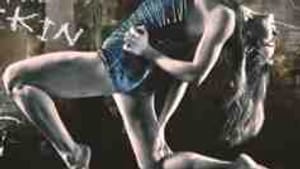Stay in the Loop
BSR publishes on a weekly schedule, with an email newsletter every Wednesday and Thursday morning. There’s no paywall, and subscribing is always free.
Our bodies, ourselves
'Through the Skin' by Koresh Dance Company

"First there was the universe, then there was the rest of us."
By itself, this line is a facile snippet of pop philosophy. But when it's played over a loud speaker as nine writhing, joyful bodies glide across a blank stage, these words take on a whole new meaning. In Through the Skin, Koresh Dance Company articulates with breathtaking beauty the modern relationship between body and mind and invites the audience to do likewise.
Through the Skin is more than just a conceptual piece about the relationship between mind and body; dance, a highly physical medium, speaks to the mind in a way that words and images can't. Modern dance is perhaps one of the most powerful art forms for exploring our modern relationship to the body.
Through the Skin is based on a poem of the same name, which is recited during the second movement of the performance. The dancers' shouts and pants remind the audience that these moving forms do, in fact, represent the human experience. But in an instant these gasping dancers are transformed into a single, breathing machine with mesmerizing patterns of movement and form. One dancer would begin running in place at an easy jog, until, as if being chased, the lone dancer begins to run faster and faster until a sudden collapse or fall.
It seemed like a metaphor for man's constant desire to know more, to progress, to master new technology. Yet only in the arms of the other dancers could these runners be restored to health.
Old records, modern beeps
Each musical composition created a unique tone of either nostalgia (through the use of old, scratchy recordings), or modern electronic beeps. The lighting was an astutely integral part of the mood: The body and its experience is deeply tied to cycles of light and dark.
Much of the music drew from various cultural traditions, with the effect of transporting the performers around the world and universalizing the message. In "Bang, Bang, Banging," two female dancers, Alexis Viator and Asya Zlatina, floated around the stage in a beautiful harmony set to the tone of Celtic fiddles. Don't forget, this piece seems to say, that we experience joy through our skin.
Perhaps the most moving pieces consisted of small groups of two, three or four, that fully explored the play between individual and group. In one movement, "Skin and Bones," four dancers began standing in rectangles of light that resemble grave plots. Each dancer exploded with energy only to be broken down, thrown to the ground by some seemingly external force. What is this destructive force? Dance has the potential of plumbing our psychological depths as we attempt to pick apart the separations between internal and external.
Women's mysterious bodies
Another small group piece, "Clash of the Humdrum," involved three female dancers, formed in a tight triangle and synchronized in especially sensual movements. Was this movement meant to be sexual? In dance, unlike many other art forms, the separation between the sensual and the chaste is never quite clear. Women's bodies, in particular, are beautiful, sensual, mysterious; and society may assign women particular roles (often defined by their bodies). But this piece illustrated the multi-faceted nature of every body.
I didn't quite grasp the precise connection between each "movement." Neither, apparently, did the rest of the audience, which seemed uncertain whether to applaud after each movement. But I was happy to float along with the audience. That's the nature of modern dance: conventions have been stripped away to expose pure, unadulterated art.
Through the Skin doesn't merely suggest the disconnect between our bodies and our modern obsession with the intellect. In a society that increasingly places higher value on the intellect than on instinct and intuition, the writhing, playful bodies that slide across the stage reconnect the human experience with our physical bodies. It takes a dance company like Koresh to illustrate the deep and powerful ways that we use and abuse our bodies in our faltering attempts to understand our universe.
By itself, this line is a facile snippet of pop philosophy. But when it's played over a loud speaker as nine writhing, joyful bodies glide across a blank stage, these words take on a whole new meaning. In Through the Skin, Koresh Dance Company articulates with breathtaking beauty the modern relationship between body and mind and invites the audience to do likewise.
Through the Skin is more than just a conceptual piece about the relationship between mind and body; dance, a highly physical medium, speaks to the mind in a way that words and images can't. Modern dance is perhaps one of the most powerful art forms for exploring our modern relationship to the body.
Through the Skin is based on a poem of the same name, which is recited during the second movement of the performance. The dancers' shouts and pants remind the audience that these moving forms do, in fact, represent the human experience. But in an instant these gasping dancers are transformed into a single, breathing machine with mesmerizing patterns of movement and form. One dancer would begin running in place at an easy jog, until, as if being chased, the lone dancer begins to run faster and faster until a sudden collapse or fall.
It seemed like a metaphor for man's constant desire to know more, to progress, to master new technology. Yet only in the arms of the other dancers could these runners be restored to health.
Old records, modern beeps
Each musical composition created a unique tone of either nostalgia (through the use of old, scratchy recordings), or modern electronic beeps. The lighting was an astutely integral part of the mood: The body and its experience is deeply tied to cycles of light and dark.
Much of the music drew from various cultural traditions, with the effect of transporting the performers around the world and universalizing the message. In "Bang, Bang, Banging," two female dancers, Alexis Viator and Asya Zlatina, floated around the stage in a beautiful harmony set to the tone of Celtic fiddles. Don't forget, this piece seems to say, that we experience joy through our skin.
Perhaps the most moving pieces consisted of small groups of two, three or four, that fully explored the play between individual and group. In one movement, "Skin and Bones," four dancers began standing in rectangles of light that resemble grave plots. Each dancer exploded with energy only to be broken down, thrown to the ground by some seemingly external force. What is this destructive force? Dance has the potential of plumbing our psychological depths as we attempt to pick apart the separations between internal and external.
Women's mysterious bodies
Another small group piece, "Clash of the Humdrum," involved three female dancers, formed in a tight triangle and synchronized in especially sensual movements. Was this movement meant to be sexual? In dance, unlike many other art forms, the separation between the sensual and the chaste is never quite clear. Women's bodies, in particular, are beautiful, sensual, mysterious; and society may assign women particular roles (often defined by their bodies). But this piece illustrated the multi-faceted nature of every body.
I didn't quite grasp the precise connection between each "movement." Neither, apparently, did the rest of the audience, which seemed uncertain whether to applaud after each movement. But I was happy to float along with the audience. That's the nature of modern dance: conventions have been stripped away to expose pure, unadulterated art.
Through the Skin doesn't merely suggest the disconnect between our bodies and our modern obsession with the intellect. In a society that increasingly places higher value on the intellect than on instinct and intuition, the writhing, playful bodies that slide across the stage reconnect the human experience with our physical bodies. It takes a dance company like Koresh to illustrate the deep and powerful ways that we use and abuse our bodies in our faltering attempts to understand our universe.
What, When, Where
Koresh Dance Company: Through the Skin. Ronen Koresh, choreographer. May 5-8, 2011 at Suzanne Roberts Theatre, 480 S. Broad St. (at Lombard).
(215) 751-0990 or www.koreshdance.org.
Sign up for our newsletter
All of the week's new articles, all in one place. Sign up for the free weekly BSR newsletters, and don't miss a conversation.

 Madeline Schaefer
Madeline Schaefer